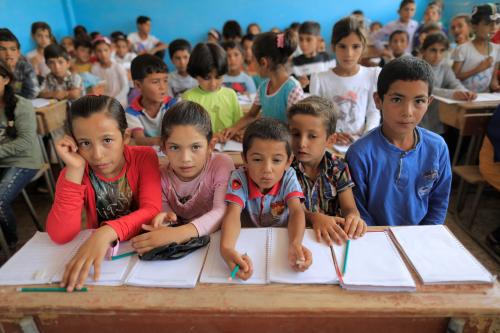Despite increases in access to education, we face a global learning crisis: In 2019, it was estimated that over half of children in low- and middle-income countries (LMICs) could not read and understand a simple text by the age of 10. The COVID-19 crisis has only exacerbated this learning poverty, as school closures have resulted in an increase to an estimated 70 percent of children in LMICs experiencing learning poverty today. In order for funders to successfully help reverse the learning crisis, they will require explicit information on both the costs and effectiveness of education interventions to make informed decisions.
While recently there has been increasing attention to measuring and ensuring an intervention’s effectiveness, there is a paucity of high-quality cost data and even less on how it relates to effectiveness. In a resource-constrained world, not having the full picture means donors, policymakers, and education organizations cannot make informed investment decisions. For example, with cost-effectiveness information a funder might consider a somewhat less effective intervention to be a better investment if it is much cheaper, thus allowing many more students to benefit. For program implementers, understanding the cost-effectiveness of different levers within their interventions can help them double down on those that drive the greatest value, and let go of resource-intensive activities that make little difference in student outcomes. Furthermore, an understanding of what cost-effective interventions should cost provides a good target for implementers as they design programs, and for funders to reference as they set budgets and expectations for their grantees.
Given the double burden of the learning crisis and constrained government and donor budgets, spending must be oriented toward smart investments in future outcomes. More than ever, it is critical to have quality data on costs and evidence on cost-effectiveness.
We at the Center for Universal Education (CUE) at Brookings and Dalberg have independently been working to improve access to resources and evidence to contribute to the global knowledge base on costs and effectiveness and the combination of the two. CUE, as part of a broader project focused on the collection, analysis, and use of data to achieve learning outcomes in education and early childhood development (ECD), initiated research on costs and costing data in 2014. Dalberg Advisors, in partnership with British Asian Trust, UBS Optimus Foundation, and the Foreign, Commonwealth and Development Office (FCDO), have recently assessed the cost-effectiveness of education interventions in government schools in India and analyzed how results-based financing mechanisms and COVID-19 may change them.
Costing
At CUE, this effort is two-pronged: The Center co-leads with the ECD Action Network (ECDAN) a costing working group, the Global Education and ECD Costing Consortium (GEECC), aimed at improving awareness of and access to costing resources and cost data. In addition, CUE is in the process of finalizing the Childhood Cost Calculator (C3), intended to facilitate cost analysis exercises, often referred to simply as “costing” of ECD and basic education interventions and programs. C3 is an online, soon-to-be publicly accessible costing tool that allows the user to enter costing data in a guided survey form that can provide a range of calculations, estimates, or simulated costs. This calculator was based on the Standardized ECD Costing Tool (SECT), which was developed earlier by CUE with the aim of providing methodological consistency to costing the full range of ECD interventions and to generate costing data for policymakers, donors, program implementers, and researchers to make informed and effective investment decisions.
C3 aids in answering the following questions:

The tool includes a number of different cost classifications such as: cost categories, resource types, investment versus recurrent costs, and imputed (donated) resource costs. It also includes functionalities such as currency conversions and amortization. Data collected through C3 costing exercises will be available in the Cost Data Explorer, an interactive database available on the website where the tool is housed. This will allow funders, implementers, and policymakers to explore the range of costs by type of program and context facilitating their decisionmaking processes. In the first quarter of 2022, CUE will pilot C3 in several countries and plans to launch it in the second quarter, so stay tuned for more information on using this resource very shortly.
Cost-effectiveness
The cost-effectiveness study in India by Dalberg and its partners is a starting point in plugging important knowledge gaps around effective ways to support student learning. It provides guidance on what costs to expect per learning outcome for effective education interventions in India and on what to invest in and for how much. The impetus for the study was the availability of robust cost and effectiveness data from the Quality Education India Development Impact Bond (QEI DIB). As payments are tied to results, an impact bond generates some of the purest cost and effectiveness data in the education sector. One of QEI DIB’s aims was to measure such data on a range of education delivery models to inform the allocation of future funding in the Indian education sector. This study augmented the QEI DIB intervention data with high-quality evidence on about 20 additional programs.
The study found that it costs around $13-40 per student (or about 5-15 percent of annual expenditure per student) for high-quality in-person interventions in government schools in India to deliver an additional year of learning beyond what an average student learns. Remedial and Teaching at the Right Level (TaRL) interventions are among the most cost-effective measures that can be easily adopted, while education technology can be powerful when combined with the right infrastructure and human resources. Another key finding was that QEI interventions led to a 50 percent increase in outcomes when compared to similar grant-funded programs, even though the costs were not higher.* This finding signals a vast potential for outcomes-based financing mechanisms to improve cost-effectiveness through higher transparency and accountability.
While it serves as a good starting point, the study could only assess six types of interventions because there was limited cost and effectiveness data for other interventions. It also leaves several important questions unanswered, such as how the cost-effectiveness of interventions differs across key demographic and contextual differences (e.g., gender, rural versus urban schools, and high- versus low-capacity states). Tools such as CUE’s C3 could be extremely useful to collect better costing data alongside the effectiveness data.
An outcomes-oriented future
Given the double burden of the learning crisis and constrained government and donor budgets, spending must be oriented toward smart investments in future outcomes. More than ever, it is critical to have quality data on costs and evidence on cost-effectiveness. Moreover, as funders increasingly tie funding to outcomes, either through traditional results-based financing or impact bonds and outcomes funds, the need to more accurately price outcomes will rise. We are seeing this, for example, with the establishment of the Education Outcomes Fund, which will be launching projects in Ghana and Sierra Leone, and a soon-to-be-launched Back-to-School Outcomes Fund in India. If prices are set too low, these initiatives may not attract enough implementing partners to participate, while if set too high, they will not provide enough value for funders. Cost-effectiveness benchmarks help set smart outcome prices, and ultimately encourage innovation by incentivizing implementers to achieve outcomes within these set prices.
*Note: This does not imply that program budgets should be reduced going forward. There are certain fixed costs per child—even if more outcomes can be expected per child, costs may not be reducible.
-
Acknowledgements and disclosures
Brookings is committed to quality, independence, and impact in all of its work. Activities supported by its donors reflect this commitment and the analysis and recommendations are solely determined by the scholar. Support for this blog post was provided by the British Asian Trust.








Commentary
Getting both costs and effectiveness right to improve decisionmaking in education
December 23, 2021